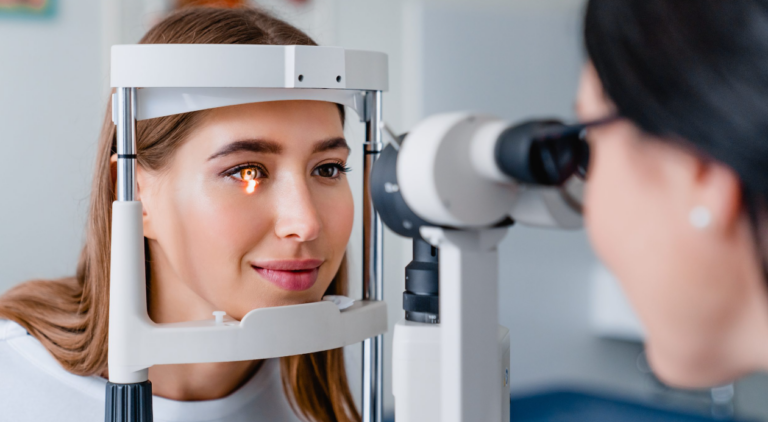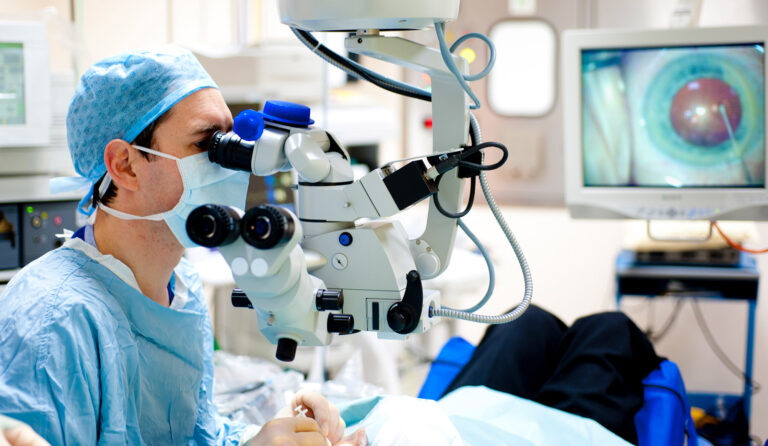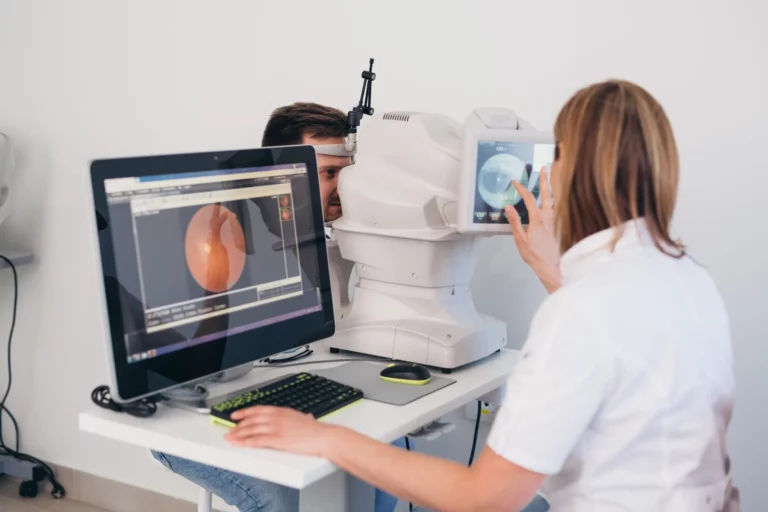Maintaining proper eye health is essential for preventing retinal conditions and preserving vision. By making certain lifestyle changes and regularly visiting eye care professionals, you can significantly reduce your risk of developing retinal diseases and disorders. In this article, we will explore the role of the retina in vision, examine common retinal conditions, discuss the impact of lifestyle on eye health, emphasize the importance of routine eye care, and provide practical steps to prevent retinal conditions.
Understanding Retinal Conditions
The retina, located at the back of the eye, plays a crucial role in the process of vision. It contains specialized cells that convert light into electrical signals, which are then sent to the brain for interpretation. However, various factors can lead to retinal diseases and disorders, affecting the retina’s ability to function effectively.
Understanding the intricate workings of the retina is essential in comprehending the impact of retinal conditions on vision. The retina consists of several layers, each with specific functions to ensure clear and accurate vision. The outermost layer, known as the pigmented epithelium, absorbs excess light and provides nourishment to the other layers. The photoreceptor layer, comprising rods and cones, captures light and converts it into electrical signals. These signals are then transmitted to the bipolar cell layer, which further processes the information and sends it to the ganglion cell layer. The ganglion cells collect the processed signals and form the optic nerve, which carries the visual information to the brain for interpretation.
The Role of the Retina in Cataracts
The intricate structure and precise functionality of the retina are crucial elements for maintaining clear and accurate vision. As light enters the eye, passing through the cornea and lens, it eventually reaches the retina. Here, photoreceptor cells engage in phototransduction, a complex process converting light into electrical signals.
These signals then embark on a journey through the various layers of the retina, undergoing meticulous processing and refinement. The refined signals are subsequently dispatched to the brain via the optic nerve, where they are interpreted as coherent images.
Understanding the interplay of these intricate processes is particularly relevant in the context of cataracts, as any disruption to the clear passage of light through the lens can impact the retina’s ability to capture and transmit visual information accurately. The fascinating precision and coordination within the retina highlight its significance in the complex landscape of vision, especially when navigating the challenges posed by cataracts.
Common Retinal Diseases and Disorders
Retinal conditions can manifest in different ways, but some common disorders include age-related macular degeneration (AMD), diabetic retinopathy, retinal detachment, and retinitis pigmentosa. These conditions can significantly impact vision and require prompt medical attention to prevent further deterioration.
Age-related macular degeneration (AMD) is a progressive retinal disease that affects the macula, the central part of the retina responsible for sharp, detailed vision. It is more common in older adults and can lead to a gradual loss of central vision, making it difficult to read, recognize faces, or perform daily tasks that require clear vision.
Diabetic retinopathy is a complication of diabetes that affects the blood vessels in the retina. High blood sugar levels can damage the blood vessels, causing them to leak or become blocked. This can lead to vision loss or even blindness if left untreated. Regular eye exams and proper management of diabetes are crucial in preventing and managing diabetic retinopathy.

Retinal detachment occurs when the retina detaches from its normal position at the back of the eye. This can happen due to trauma, aging, or other underlying retinal conditions. When the retina detaches, it loses its blood supply and nutrients, leading to vision loss. Immediate medical intervention is necessary to reattach the retina and restore vision. By visiting https://georgiawellnessclinic.com/observe-these-dos-and-donts-after-your-cataract-surgery/ you can read about Observe these do’s and don’ts after your cataract surgery.
Retinitis pigmentosa is a genetic disorder that causes the breakdown and loss of cells in the retina. It often starts with night blindness and gradually progresses to tunnel vision or complete blindness. While there is currently no cure for retinitis pigmentosa, various treatment options, such as low vision aids and gene therapy, can help manage the condition and improve quality of life.
Understanding the different retinal diseases and disorders is crucial in recognizing their symptoms and seeking timely medical intervention. Regular eye exams and early detection can play a significant role in preserving vision and preventing further deterioration.
The Impact of Lifestyle on Eye Health
Your daily habits and lifestyle choices can have a profound effect on your eye health. By adopting a vision-friendly diet, engaging in regular exercise, and avoiding harmful substances, you can help safeguard the health of your retinas.
When it comes to maintaining healthy eyes, diet and nutrition play a crucial role. Eating a well-balanced diet rich in vitamins, minerals, and antioxidants is essential. Incorporating foods like dark leafy greens, colorful fruits and vegetables, omega-3 fatty acids, and vitamin C into your meals can support retinal health. These nutrients provide the necessary building blocks for maintaining optimal eye function and preventing age-related macular degeneration and cataracts.
But it’s not just about what you eat; regular physical activity also has a positive impact on your eyes. Engaging in exercises that promote cardiovascular health can enhance blood flow to the eyes, keeping the retinas nourished and oxygenated. Whether it’s going for a brisk walk, cycling, or participating in aerobic exercises, staying active can contribute to better eye health.
While adopting a healthy lifestyle is crucial, it’s equally important to be aware of the harmful substances that can negatively affect your retinal health. Smoking and excessive alcohol consumption are two habits that can have detrimental effects on your eyes. The chemicals present in tobacco smoke and the toxins in alcohol can damage the blood vessels in the eyes, increasing the risk of retinal diseases such as diabetic retinopathy and macular degeneration. Quitting smoking and limiting alcohol intake can significantly reduce these risks and help preserve your vision for years to come.
Furthermore, it’s worth noting that maintaining a healthy weight is also beneficial for your eye health. Obesity and being overweight can increase the risk of developing conditions like glaucoma and diabetic eye disease. By maintaining a healthy weight through a combination of a balanced diet and regular exercise, you can reduce the likelihood of these eye conditions and promote overall well-being.
In conclusion, taking care of your eyes goes beyond just wearing glasses or contact lenses. It involves making conscious lifestyle choices that support and protect your retinal health. By adopting a vision-friendly diet, engaging in regular exercise, and avoiding harmful substances like smoking and excessive alcohol consumption, you can take proactive steps to safeguard your eyes and maintain optimal vision throughout your life.
Routine Eye Care and Its Importance
Regular eye care is essential for the early detection and management of retinal conditions. By undergoing comprehensive eye examinations and understanding the importance of various eye tests and screenings, you can stay proactive in preserving your retinal health.
When it comes to maintaining healthy eyes, prevention is key. Many retinal conditions, such as age-related macular degeneration and diabetic retinopathy, often develop without noticeable symptoms in the early stages. Regular eye examinations can help detect these conditions before they progress and cause irreversible damage to your vision.
Regular Eye Examinations: Why They Matter
Scheduling regular eye examinations allows eye care professionals to assess your overall eye health and detect any early signs of retinal conditions. Early diagnosis can lead to timely intervention and better outcomes, preventing further vision loss.
During a comprehensive eye examination, your eye care professional will not only evaluate your visual acuity but also perform various tests to assess the health of your retinas. These tests may include a visual field test, which measures your peripheral vision, and a slit-lamp examination, which allows the doctor to examine the structures at the front of your eye in detail.
Furthermore, a dilated eye exam is often performed during regular eye examinations. This involves the use of eye drops to enlarge your pupils, allowing the doctor to get a clear view of the back of your eye, including the retina. By examining the retina, the eye care professional can identify any abnormalities or signs of retinal diseases. Click here to read about Access to Eye Care in the United States: Evidence-Informed Decision-Making Is Key to Improving Access for Underserved Populations.
Understanding Eye Tests and Screenings
Eye tests and screenings, such as visual acuity tests, tonometry, and dilated eye exams, play a crucial role in identifying retinal abnormalities. These tests help eye care professionals determine the condition of your retinas and recommend appropriate treatments or preventive measures.
Visual acuity tests, commonly known as the “eye chart” test, measure how well you can see at various distances. This test helps determine if you have any refractive errors, such as nearsightedness or farsightedness, which can affect your overall visual health.
Tonometry is another important test that measures the pressure inside your eyes. Elevated eye pressure can be a sign of glaucoma, a condition that can damage the optic nerve and lead to vision loss if left untreated.
Regular screenings for retinal conditions are especially important for individuals at higher risk, such as those with a family history of retinal diseases, diabetes, or high blood pressure. These screenings can help detect any early signs of retinal abnormalities and allow for timely intervention.
The Role of Eye Care Professionals in Retinal Health
Eye care professionals, including optometrists and ophthalmologists, are specialized in diagnosing and treating retinal conditions. Regular consultations with these professionals ensure that your retinas are monitored and any issues are addressed promptly.
Optometrists are primary eye care providers who can perform comprehensive eye examinations, prescribe corrective lenses, and diagnose and manage various eye conditions. If necessary, they can refer you to an ophthalmologist, who is a medical doctor specializing in eye care and surgery.
Ophthalmologists have extensive training in diagnosing and treating retinal diseases. They can perform advanced procedures, such as retinal laser surgery or intravitreal injections, to manage conditions like diabetic retinopathy or macular degeneration. Regular visits to these eye care professionals are crucial for maintaining optimal retinal health.
In conclusion, routine eye care, including regular eye examinations and understanding the importance of various eye tests and screenings, is vital for preserving your retinal health. By staying proactive and seeking professional care, you can detect retinal conditions early and take appropriate measures to protect your vision.
Practical Steps to Prevent Retinal Conditions
Building healthy habits and incorporating proactive measures into your daily routine can significantly reduce the risk of retinal conditions. By adopting a vision-friendly diet, engaging in eye-healthy exercises, and making lifestyle changes, you can take control of your retinal health.
Adopting a Vision-Friendly Diet
Include foods rich in vitamins A, C, and E, as well as lutein and zeaxanthin, in your diet. These nutrients contribute to retinal health and can be found in carrots, citrus fruits, nuts, and green leafy vegetables. Additionally, omega-3 fatty acids from sources like fish and flaxseeds can support overall eye health.
Incorporating Eye-Healthy Exercises into Your Routine
Engage in exercises that promote eye health, such as eye yoga, focusing exercises, and eye massages. These activities can help strengthen the eye muscles, improve blood circulation, and relieve eye strain caused by excessive screen time.
Quitting Smoking and Limiting Alcohol for Retinal Health
If you are a smoker, quitting smoking should be a top priority. Seek support from healthcare professionals or support groups to overcome this habit. Similarly, limit alcohol consumption to reduce the risk of retinal diseases associated with excessive drinking.
In conclusion, preventing retinal conditions requires a multifaceted approach. By understanding the role of the retina in vision, making lifestyle changes to promote eye health, and prioritizing routine eye care, you can take proactive steps to safeguard your retinal health. Incorporating vision-friendly habits into your daily life can go a long way in reducing the risk of developing retinal diseases and preserving your vision for years to come.




